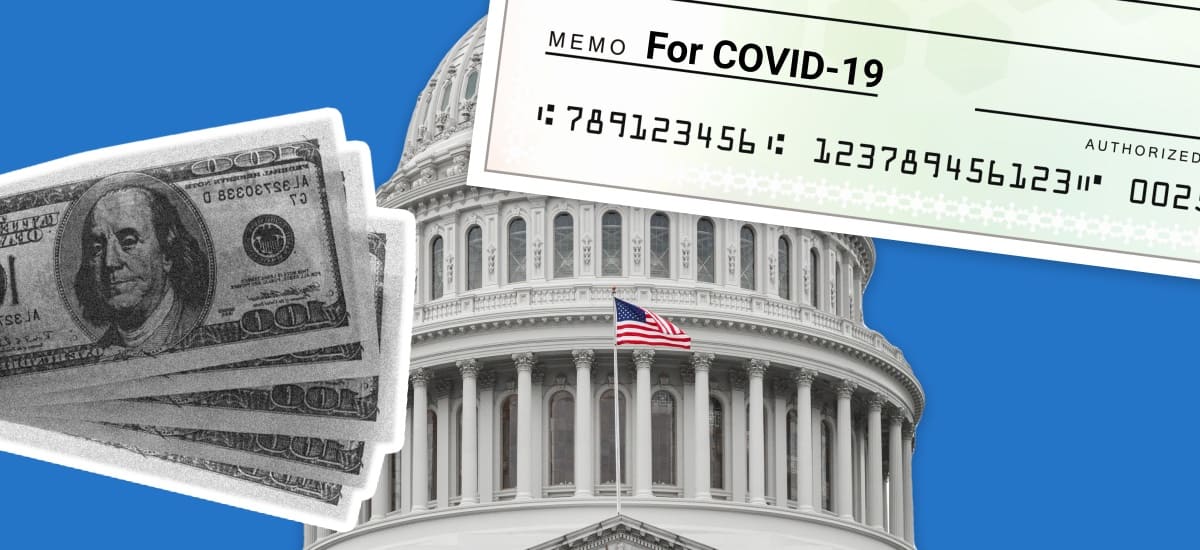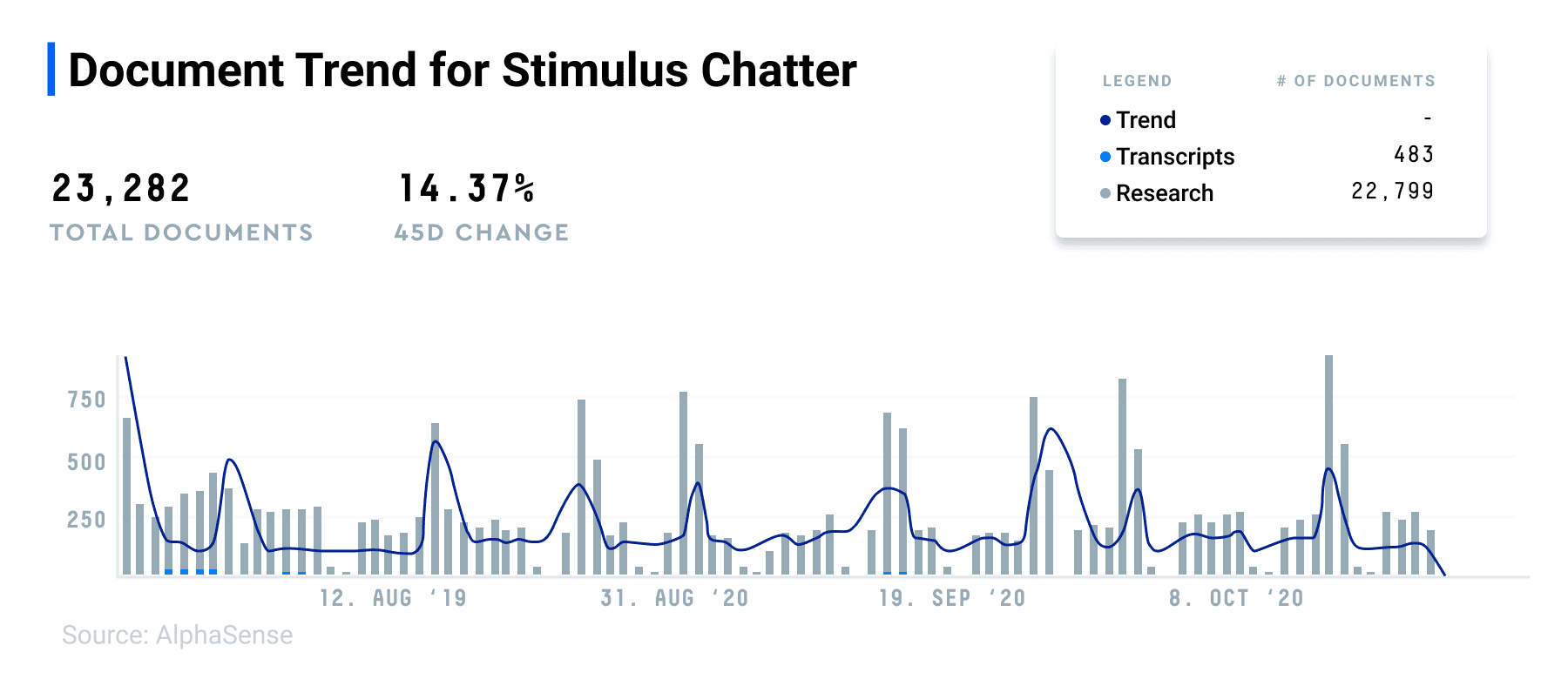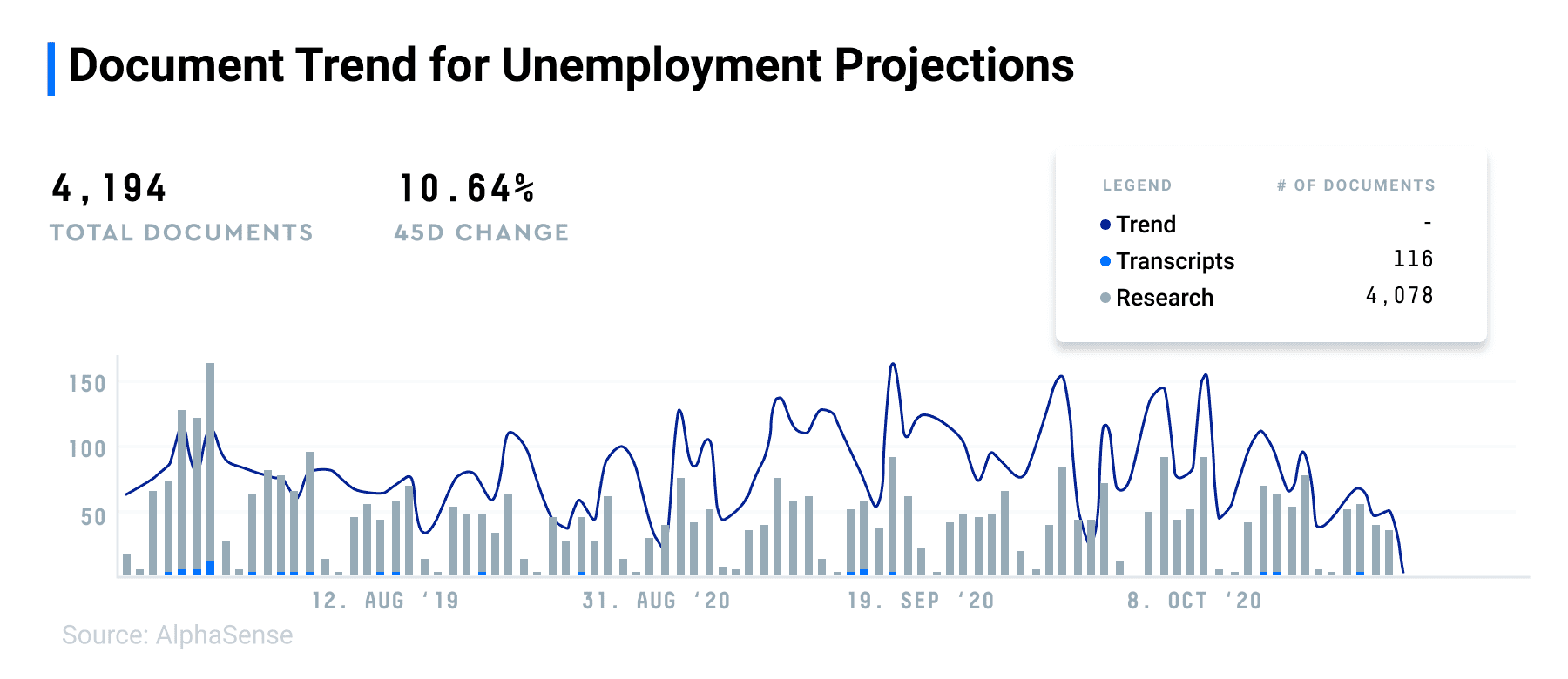The start of Q3 earnings was marked by continued uncertainty surrounding a new stimulus bill on the floor of Congress. As Democrats pushed for an agreement, the stock market saw early sell-offs on Monday followed by gains on Thursday after House Speaker Nancy Pelosi signaled that they are “just about there” in regards to reaching a deal.
With previous stimulus benefits having since expired and as COVID-19 cases rise again towards a third wave in the U.S., analysts are keen to understand the impact of the potential bill and how companies are factoring it into their end of year projections. The topic has quickly become one of the hottest this earnings season, with executives across industries weighing in on the issue.
Corporate leaders noted the success of the previous stimulus bill in helping lessen the blow of wide-spread unemployment. Here are their comments on how they’re thinking about the potential for a second stimulus bill and how unemployment may factor into their projections as they close out the year.
Takeaways:
- PNC on stimulus: “The consumer number in my view is going to be highly dependent on whether they provide more fiscal stimulus, which I think they absolutely need to do.”
- Discover Financial on reserves: “It will start to impact the prime revolver base. And that’s why we’re conservative in terms of our reserve outlook here for the third quarter.”
- Walgreens Boots on consumer spending: “Some slowdown was evident in August and a slight slowdown in September as well because there was less stimulus money out there. And you can actually see the impacts.”
- JPMorgan Chase on delinquencies: “So we do think you’ll start to see delinquencies tick up early 2021 and then charge-offs in the back half of 2021. I think future stimulus would give us more confidence in the economy delivering on the base case.”
- U.S. Bancorp on unemployment: “Our base case outlook assumes an unemployment rate of 8.9% for the third quarter, increasing slightly to 9.1% in the fourth quarter of 2020 before declining somewhat to 7.8% by the fourth quarter of 2021.”
Below we’ve compiled executive commentary from earnings calls on forward-looking views as it relates to the stimulus bill and unemployment. AlphaSense can track management commentary in real-time across the entire market, by industry, or watchlist. To track how companies are being impacted by the stimulus bill, unlock free trial access to AlphaSense or login to your account.
On the Stimulus Bill
Document trend for stimulus chatter across transcripts and broker research for companies with a $5B market cap over the past 90 days.
There’s enormous bipartisan support for an extension, but unfortunately, our elected officials still haven’t been able to get enacted. Because they’ve been unable to agree on broader COVID relief legislation.
So without the extension, we had defer (inaudible) 19,000 of our team members beginning October 1, and we discontinued service to numerous markets around the country. We remain hopeful that our elected officials can come together on this important legislation on behalf of our team, our industry and working Americans in our economy at large.
Elections matter. But there’s nothing pulling higher than support for a COVID relief stimulus package.
Discover Financial Services – 10/22
Okay. Yes. So I’ll talk about the credit outlook and then handle the mortgage question on the back end. So in terms of the stimulus that we modeled, and it is one of many inputs, and we’ll look at what happens in the fourth quarter and see how the roll rates are progressing in the portfolio through the quarter to get, I’ll say, a bottoms-up view of actually the impact there. So no specific information on that other than to say that underlying roll rates are far more positive than we thought they would be at this time.
And if another round of stimulus doesn’t come in, I think that’s going to be tough for a number of people that have been impacted by the pandemic. And progressively, it will start to impact the prime revolver base. And that’s why we’re conservative in terms of our reserve outlook here for the third quarter. But overall, we’re — again, we’re pleased with our positioning.
But also, it depends how a Democrat or a Republican win will determine how money that will most likely come through a stimulus package that we believe is going to come in any case will be floating to the economy.
So I only can tell you what clients are telling us, that almost 2/3 of them are planning to change their asset allocation after the election. And that tells you the story in my point of view. So — but how they do it, when they do it, it’s not 100% clear. There are also other factors that may determine this.
And I do think the stimulus relief is really the linchpin here. It’s the largest thing, but also our consumers and our businesses have changed their habits as well. For example, for consumers, what we’re seeing is they’re not spending their money on things like the $10,000 vacation. That money is now just going into the bank and putting it away for it, put coats around the word of rainy day. The rainy day is here, but you’re being very prudent with their money.
Of course, the stimulus has really helped with that to make sure they build a bit of an estate for themselves as they work their way through to better times. But we’re seeing that on the consumer side most definitely. And you can — I thought perhaps maybe we would, therefore, see a lot of drawdowns in things like, on the consumer side, in our home equity lines. We haven’t seen that. Or cashout refi is on our mortgages. We haven’t seen that neither.
Generally speaking, the U.S. consumer entered 2020 on solid footing and has demonstrated a higher degree of resiliency, despite significant and ongoing challenges, aided by meaningful and necessary fiscal stimulus. While recent trends suggest a broader recovery is underway in various pockets of the economy, we’re mindful of the currently expired stimulus benefits and the ongoing uncertainty around the outlook of COVID.
Walgreens Boots Alliance – 10/16
So we’ve looked at the economics. We’ve actually seen it play out in the most recent quarter. So we had quite a strong June, July, and some slowdown was evident in August and a slight slowdown in September as well because there was less stimulus money out there. And you can actually see the impacts. So — and I think you see it across retail, in general. So a lot does depend — the forecast do depend on the stimulus that are put in the market by — particularly in the U.S., which is very sensitive for this.
Truist Financial Corporation – 10/15
So I think you’ll see in our estimate this quarter we’ve been, I think, prudent around considering there’s still a lot of economic uncertainty around whether there’ll be any more stimulus, what the ultimate outcome of these accommodations are and just the pace of the recovery. So I think for us, we would want to be sure we have much better clarity there and see the economy on a very firm ground and the client performance be at a really strong level before I think you’d see us consider releases.
In determining our allowance, we considered current economic conditions, which improved compared with prior expectations as unemployment levels decreased during the third quarter. We also considered that recent credit performance reflected the support of fiscal stimulus, lender accommodations and borrowers’ ability to access liquidity. These factors drove lower loss expectations in our quantitative models. However, there is increased uncertainty in economic forecasts that vary widely, and future credit performance may deteriorate as stimulus effects that benefited recent credit performance come to an end.
PNC Financial Services – 10/14
It’s — again, it depends on a lot of things, not the least of which is what fiscal stimulus they put out there, if any. But all else equal, it probably starts showing up in the second half of next year. My own belief is we’re probably going to see more pressure on COVID-sensitive industries, real estate earlier on and then consumers flow through as we get into the back half of next year. But it all depends. We’re — the consumer number in my view is going to be highly dependent on whether they provide more fiscal stimulus, which I think they absolutely need to do.
There were — so a stimulus plan would help the unemployed; the businesses that are still struggling to get their business capacity — get their business utilization up, those obvious businesses we all know; and then states and towns so they don’t have further reduction in budgets in schools and other things; the hospitals. All of these people have been heavily affected. Stimulus affecting those would help all these — speed up the pace of the estimates coming down, quite frankly.
Right now, there hasn’t been — right now, there’s — it’s not baked in, as Paul said earlier, but stimulus coming in would move us further. And you’d see the reserves come out further because the lifetime expectation loss would be lower.
We — the credit stats for the consumer portfolio are really good right now. And the indicators, the delinquencies, all those facts are more positive than you would expect given the economic environment that we’re in. Part of that certainly is due to the stimulus plans, the unemployment benefits, all those things, which is creating a bit of a bridge. I do expect that at some point in 2021. We’ll start to see an acceleration of credit deterioration in the consumer portfolios once that — once those benefits start to wear down.
And so look, again, that is based on kind of current trends that we’re seeing in terms of roughly improving unemployment and improving GDP. Obviously, there is talk of another stimulus in terms of its impact. We’ve assumed that kind of a bit later in terms of in the first quarter of 2021. It does assume that we continue to see the purchase sales activity improve quarter-over-quarter.
Well, I think we — one of the reasons we haven’t seen delinquencies tick up is because of the payment relief, but also the extraordinary support that has been provided through stimulus. So we’ll probably see delinquencies tick up in the early part of 2021. We’re not assuming further stimulus beyond the end of this year and how we think about reserves.
So we do think you’ll start to see delinquencies tick up early 2021 and then charge-offs in the back half of 2021. I think future stimulus would give us more confidence in the economy delivering on the base case. There’s a lot of factors that we’ll be looking at as we think about the right level of our reserves over the coming quarters. And delinquencies will be just one part of that.
When I think about what’s happening with the consumer right now and looking forward with this recession that we are sitting in today and the fact that there has been no incremental stimulus brought to the consumer, I look forward and believe that our value platforms and sticking to those platforms will only be more important as we look out into the months and quarters ahead.
You’re right, about 80%, what we’ve seen in general surveys, not just our clients, but in general, about 80% are saying they’re at the end of the first loan, about 40% to 45% are saying they need additional stimulus.
We think it’s important that they get additional stimulus. What Efrain was saying that in our forecast, we have not built that in to say that, that’s going to be a big impact. And we have not built in that they’re going to get it, and that’s going to have a big impact. So as we look out, the hardest thing is forecasting the second half of the year because one, we did much better than we thought in the first quarter. We can kind of see what’s happening into the second quarter, that’s probably fairly predictable. What’s really unpredictable is the second — the third and fourth quarters, fourth quarter, in particular, where we estimated already that there was going to be a positive growth year-over-year. Now it’s a better compare, obviously, to a tough fourth quarter previous year. But it’s hard to predict. So I think the another stimulus for small and midsized businesses absolutely needed. It needs to have more flexibility. It needs to have an easier way to forgive the loans. Is that going to happen? I don’t know.
On Unemployment
Document trend for unemployment projections across transcripts and broker research for companies with a $5B market cap over the past 90 days.
Discover Financial Services- 10/22
So we don’t expect there to be a rush of white collar unemployment. But what will be clear, and we’ve seen some of this already is businesses are sizing both their professional staff and the blue collar staff for the business at hand. And there’s enough indications today that there could be some contraction. And as such, the unemployment, numbers not exactly an easy number to predict, but we feel like as an input to our model, it’s appropriate at this point.
And as we’ve gone through and done our modeling off of that, the way which we interpret it, we actually have redistributed that unemployment curve. So effectively, the unemployment we have at the end of the year is 9.7%, down from the second quarter, 9.1% in 2021, up slightly from our previous estimate and 6.3% in 2022. So we have a little bit slower recovery back into 2021 as we think things have pushed out, which partially, as we talked about, some of the stimulus and other metrics.
Our current baseline forecast assumes unemployment remains elevated, ending 2021 around 7%. Consistent with prior quarters, we do not include any stimulus-related benefits in our reserve modeling. We continue to expect retail auto losses to peak as we move through 2021, and we believe our current reserve level is sufficient to absorb this expected increase. Absent significant further deterioration due to the economic outlook, we would not expect any additional build.
While estimates are based on many quantitative factors and qualitative judgment, our base case outlook assumes an unemployment rate of 8.9% for the third quarter, increasing slightly to 9.1% in the fourth quarter of 2020 before declining somewhat to 7.8% by the fourth quarter of 2021.
In the first quarter, our base scenario reflected a short-lived downturn followed by a recovery in the back half of 2020 with unemployment falling to 7% by year-end and full year GDP close to prior year levels. By the end of the second quarter, our base case assumed a more severe and protracted downturn this year but with a sharper recovery into next year. And now you can see we are expecting a somewhat more muted and slower recovery in both unemployment and GDP through 2022.
And could you talk a little — Jen, could you talk a little bit about the Slide 3 where you’ve got the base case outlook for unemployment? And just give us a sense as to what’s driving this base case outlook for unemployment in 4Q ’20 at 9.5% and then 20 — 2Q ’21 at 8.5%? They’re obviously above where we are today.





